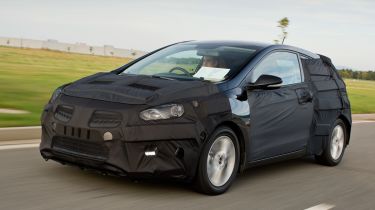Hyundai i30 3dr
We've driven a prototype of the three-door Hyundai i30, ahead of its Paris debut next week

The Hyundai i30 is a great car. Yet while it makes perfect sense as a practical five-door and is even more compelling as a cavernous Tourer estate, the new three-door model isn't as well conceived. Without chassis upgrades to complement the sportier design, it makes little sense as a halo model for the range. And unless it’s significantly cheaper than the five-door, no-one will want to sacrifice practicality.
It’s not often you see a new car in the metal before its world debut, let alone drive it. But that’s exactly what we’ve done with the new three-door version of the Hyundai i30.
This wasn’t a straightforward test drive though: we had an exclusive look at the new i30’s design ahead of its unveiling at the Paris Motor Show next week, but it had to be camouflaged while we were driving it. Also, we were only allowed try it on Hyundai’s evaluation circuit at its Nosovice plant in the Czech Republic. This is where all models leaving the factory are driven – as a final quality-control check to ensure they’re fit for customers.
The track features a range of driving surfaces, changes of camber and a mixture of banked curves and straights. Although our drive was brief, we got a reasonable idea of how new i30 performs on a variety of different roads.
Used - available now
So how does this new version feel from behind the wheel? Exactly like the five-door model, which means it steers and corners well enough and is very quiet and comfortable. This should come as no surprise, though: the three-door is mechanically identical to the five-door under the skin.
But while that makes it a competent car, Hyundai has missed an opportunity to tweak the chassis for a sportier driving experience, like Vauxhall did with the Astra GTC. The three-door’s design is certainly different from the five-door’s. You’d think the more rakish profile, redesigned bumpers and matte-effect grille would at least warrant slightly stiffer suspension. You could also argue it should have the 183bhp 1.6-litre turbo engine from the Veloster. But it won’t.
Hyundai still hasn’t decided how to market the car – even though it’s due to go on sale in just four months. At the moment it presents a conundrum. Pricing it cheaper than the five-door seems like the obvious choice, but while this works for superminis, it doesn’t makes as much sense for small family hatches, as most buyers in this class demand practicality. While the i30 three-door has a big boot and impressive rear leg and headroom (as long as you avoid the optional panoramic roof), the lack of rear doors will put most people off. That’s unless there’s a substantial cost saving – which is unlikely.
So what about pitching it as more upmarket than the five-door – like Vauxhall does with the Astra GTC? Sadly, the new design isn’t head-turning enough, so without any chassis upgrades, buyers would wonder what they’re paying extra for. Maybe Hyundai should use this opportunity to make some last- minute changes to the car's set-up before it really is too late...











